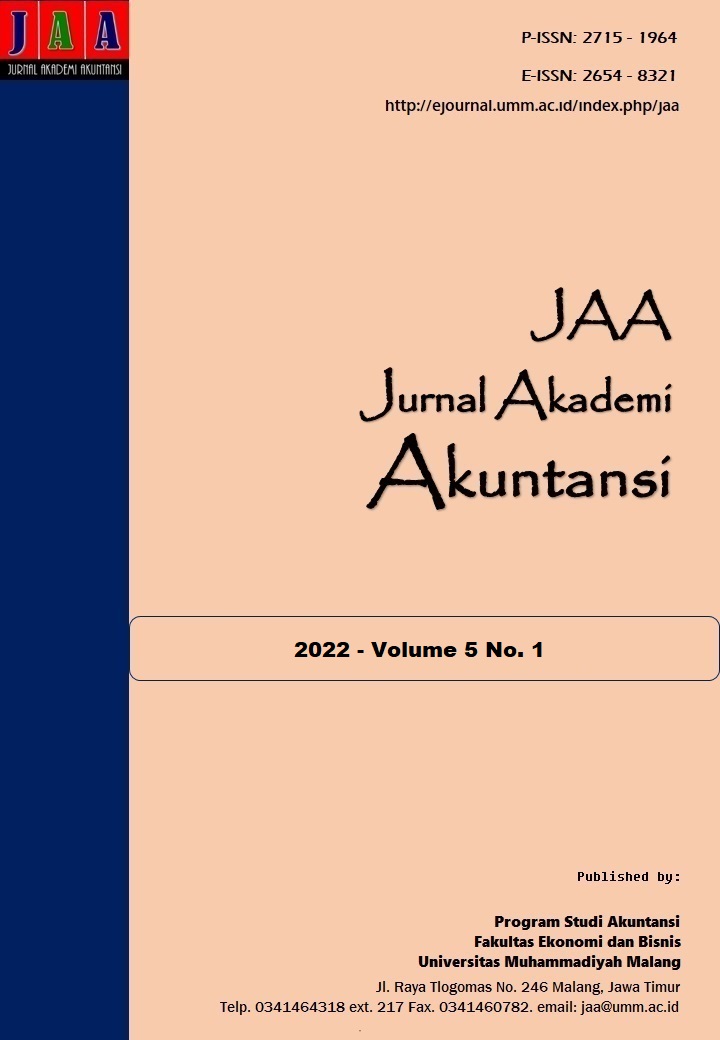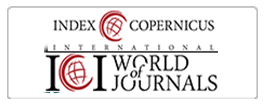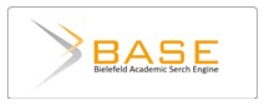Integrasi Sistem ERP, Arus Informasi Dan Kualitas Informasi
DOI:
https://doi.org/10.22219/jaa.v5i1.18054Keywords:
ERP, Information Flow, Information QualityAbstract
This paper aims to provide empirical evidence regarding the relationship between the level of integration of ERP systems and the quality of information perceived by managers directly and indirectly. The quality of information is affected by the presence of specific features of information flow, defined as information processing capacity, meeting intensity, and information sharing. This research was conducted by approaching structural equation modeling (SEM) with a test tool using partial least square (PLS). Empirical results show that the level of integration of ERP systems has a positive effect on information flow variables and information flow positively affects the quality of information. Other results also show that the level of integration of ERP systems can positively and indirectly affect the quality of information obtained by managers mediated by the flow of information. Managers can benefit from this research in supporting decision making to achieve the optimal level of integration of ERP systems used to improve the quality of information within the company.
Downloads
References
Al-Hakim, L. (2007). Information quality management: theory and applications. IGI Global.
Albrecht, W. D. (2011). 'LinkedIn’ for Accounting and Business Students. Journal of Business Education, 4(10), 39–42.
Alhatabat, Z. (2020). The Impact Of ERP System’s Adoption On Management Accounting Practices In The Jordanian Manufacturing Companies. International Journal Business Information Systems, 33(2), 267–284.
Ali, I., van Groenendaal, W. J. H., & Weigand, H. (2020). Enterprise Resource Planning Systems Implementation and Firm Performance: An Empirical Study. Journal of Information Systems Engineering and Management, 5(1), 1–16.
Ali, M. and Miller, L. (2017). ERP System Implementation In Large Enterprises – A Systematic Literature Review. Journal of Enterprise Information Management, 30(4), 666–692.
AlMuhayfith, S., And Shaiti, H. (2020). The Impact Of Enterprise Resource Planning On Business Performance: With The Discussion On Its Relationship With Open Innovation. Journal of Open Innovation: Technology, Market, and Complexity, 6(3).
Alomari, I. A., & Mohd, A. (2020). ERP Business Process Attributes And Management Control To Create Competitive Advantage. Journal of Economics and Business, 28(1), 1–23.
Appelbaum, D., Kogan, A., Vasarhelyi, M., And Yan, Z. (2017). Impact Of Business Analytics And Enterprise Systems On Managerial Accounting. International Journal of Accounting Information Systems, 25, 29–44.
Baron, R, M. & Kenny, D. A. (1986). The moderator-mediator variable distinction in social psychological research: Conceptual, strategic, and statistical considerations. Journal of Personality and Social Psychology, 51(6), 1173–1182.
Bisbe, J.. Batista-Foguet, J.-M., and C. R. (2007). No TitleDefining management accounting constructs: A methodological note on the risks of conceptual misspecification. Accounting, Organisation and Society, 32(7–8), 789–820.
Burkhard R. A. and Meier, M. (2005). Tube Map Visualization: Evaluation of a Novel Knowledge Visualization Application for the Transfer of Knowledge in Long-Term Projects. Journal of Universal Computer Science, 11(4), 473–494.
Caserio, C., & Trucco, S. (2020). The Impacts of ERP Integration on Information Quality. International Journal of Management & Information Technology, 15, 1–13.
Chapman, C., & Kihn, L.-A. (2009). Information System Integration, Enabling Control And Performance. Accounting Organization Society, 34, 151–169.
Dillman, D. A. (2011). Mail and Internet surveys: The tailored design method–2007 Update with new Internet, visual, and mixed-mode guide. John Wiley & Sons.
Ganesh, K., Mohapatra, S., Anbudayasankar, S. P., & Sivakumar, P. (2014). Enterprise Resource Planning: Fundamentals of Design and Implementation. Springer Publisher.
Hair, J.F., Sartsted, M., Ringle, C.M., & Mena, J. A. (2012). An assessment of the use of partial least squares structural equation modeling in marketing research. Journal of the Academy of Marketing Science, 40(3), 414–433.
Hakim, M.Z. dan Naelufar, Y. (2020). Analysis Of Profit Growth, Profitability, Capital Structure, Liquidity And Company Size Of Profit Quality. Jurnal Akademi Akuntansi, 3(1), 12–35.
Henseler, Jörg.,. Ringle, Christian M and Sinkovics, R. R. (2009). The use of partial least squares path modeling in international marketing. New Challenges to International Marketing, 20, 277–319.
Heredia-Calzado, M., & Duréndez, A. (2019). The influence of knowledge management and professionalization on the use of ERP systems and its effect on the competitive advantages of SMEs. Enterprise Information Systems, 13(9).
Hung, N. T., Mai, T. T. H., & Duc, N. L. (2019). Influence of Management Commitment and Organizational Structure on Application of ERP System & Its Impact on Quality of Accounting Information: A Survey in Vietnamese Telecommunication Enterprises. Accounting and Finance Research, 8(1), 128–137.
Kallunki, J.-P., Laitinen, E. K., & Silvola, H. (2011). Impact of enterprise resource planning systems on management control systems and firm performance. International Journal Accounting Informations System, 12(1), 20–39.
Katuu, S. (2020). Enterprise Resource Planning: Past, Present, and Future. New Review of Information Networking, 25(1), 37–46.
Kihn, L. A., & Näsi, S. (2017). Emerging diversity in management accounting research The case of Finnish doctoral dissertations, 1945-2015. Journal of Accounting and Organizational Change, 13(1), 131–160.
Lee, L., Petter, S., Fayard, D., & Robinson, S. (2011). On the use of partial least squares path modeling in accounting research. International Journal of Accounting Information Systems, 12(4), 305–328.
Li, S. and Lin, B. (2006). Accessing information sharing and information quality in supply chain management. Decision Support System, 42(3), 1641–1656.
Niculescu, M., Irimia, C., Rosca, I, C., Grovu, M., & Guiman, V. (2016). Structural dynamic applications using principal component analysis method. International Congress of Automotive and Transport Engineering, 90–99.
Osnes, K. B., Olsen, J. R. Vassilakopoulou, P., & Hustad, E. (2018). ERP Systems In Multinational Enterprises: A Literature Review Of Post-Implementation Challenges. Procedia Computer Science, 138, 541–548.
Paoki, A.G.F., Yusha, J.D., Kale, S.E., & Mangoting, Y. (2021). The Effect of Information Technology and Perceived Risk In Anticipating Tax Evasion. Jurnal Reviu Akuntansi Dan Keuangan, 11(2), 238–249.
Percin, S. (2008). Using the ANP approach in selecting and benchmarking ERP systems. Benchmarking International Journal, 15(5), 630–649.
Pervan, I. & I., & Dropulić, I. (2019). The Impact Of Integrated Information Systems On Management Accounting: Case Of Croatia. Journal of Contemporary Management Issues, 24(1), 21–38.
Rashid, M. A., Hossain, L., & Patrick, J. . (2002). The evolution of ERP systems: A historical perspective. Willey Publishing.
Ratmono, D dan Sholihin, M. (2014). Analisis SEM-PLS Dengan WarpPLS 3.0. ANDI, Jogjakarta.
Rikhardsson, P., And Yigitbasioglu, O. (2018). Business Intelligence & Analytics In management Accounting Research: Status And Future Focus. International Journal of Accounting Information Systems, 29, 37–58.
Ringle, C. M., Sarstedt, M., & Straub, D. (2012). A Critical Look at the Use of PLS SEM. Management Information Systems Quarterly, 36(1), 3–14.
Rouissi, C. (2020). The influence of the Enterprise Resource Planning (ERP) on Management Controllers: A Study in the Tunisian Context. International Journal of Business and Management, 15(4), 25–35.
Sangster, A., Leech, S.A., & Grabsky, S. . (2009). ERP implementations and their impact upon management accountants. Journal Informations System Technology Management, 6(2), 125–142.
Sardo, F., And Alves, M. C. (2018). ERP Systems And Accounting: ASystematic Literature Review. International Journal of Enterprise Information Systems, 14(3), 18.
Shao, Z., Feng, Y., And Hu, Q. (2017). Impact of top management leadership styles on ERP assimilation and the role of organizational learning. Information and Management, 54(7), 902–919.
Spraakman, G., O’Grady, W., Askarany, D., & Akroyd, C. (2018). ERP systems and management accounting: New understandings through “nudging” in qualitative research. Journal of Accounting and Organizational Change, 14(2), 120–137.
Strother, J. B., Ulijn, J.M., & Fazal, Z. (2012). Information overload: an international challenge for professional engineers and technical communicators. John Wiley & Sons.
Su, Y., & Yang, C. (2009). The Relationship Between Benefits Of ERP Systems Implementation And Its Impacts On Firm Performance Of SCM. Journal of Enterprise Information Management, 22, 722–752.
Verma, P. & Kumar, V. (2016). The Role of Management Control System in ERP Project Implementation. Proceedings of the 2016 International Conference on Industrial Engineering and Operations Management Kuala Lumpur, 1635–1641.
Yang, X., Procopius, C. M., and Srivastava, D. (2009). Summarizing relational databases. Proceedings of the VLDB Endowment, 634–645.
Downloads
Published
Issue
Section
License
Copyright (c) 2022 Muhammad Nawawi, Edward Fazri

This work is licensed under a Creative Commons Attribution-NonCommercial-ShareAlike 4.0 International License.
Jurnal Akademi Akuntansi is licensed under a Creative Commons Attribution-NonCommercial-ShareAlike 4.0 International License.
Authors who publish with this journal agree to the following terms:
- Authors retain copyright and grant the journal right of first publication with the work simultaneously licensed under a Creative Commons Attribution-NonCommercial-ShareAlike 4.0 International License that allows others to share the work with an acknowledgment of the work's authorship and initial publication in this journal.
- Authors are able to enter into separate, additional contractual arrangements for the non-exclusive distribution of the journal's published version of the work (e.g., post it to an institutional repository or publish it in a book), with an acknowledgment of its initial publication in this journal.
- Authors are permitted and encouraged to post their work online (e.g., in institutional repositories or on their website) prior to and during the submission process, as it can lead to productive exchanges, as well as earlier and greater citation of published work (See The Effect of Open Access).
Jurnal Akademi Akuntansi dilisensikan di bawah lisensi Creative Commons Attribution-NonCommercial-ShareAlike 4.0 International.
Penulis yang menerbitkan artikel di jurnal ini menyetujui ketentuan berikut:
- Penulis mempertahankan hak cipta dan memberikan hak jurnal atas publikasi pertama dengan karya yang secara serentak dilisensikan di bawah Lisensi Pengaitan Creative Commons yang memungkinkan orang lain untuk berbagi karya dengan pengakuan atas karya penulis dan publikasi awal dalam jurnal ini.
- Penulis dapat masuk ke dalam pengaturan kontrak tambahan yang terpisah untuk distribusi non-eksklusif versi karya jurnal yang diterbitkan (misalnya, mempostingnya ke repositori institusional atau mempublikasikannya dalam sebuah buku), dengan pengakuan publikasi awalnya di jurnal ini.
- Penulis diizinkan dan didorong untuk memposting pekerjaan mereka secara online (misalnya, di repositori institusional atau di situs web mereka) sebelum dan selama proses pengajuan, karena dapat mengarah pada pertukaran produktif, serta kutipan pekerjaan sebelumnya dan yang lebih besar (Lihat Pengaruh Akses Terbuka).
























